Tag Archives: offshore wind farms

Harpswell fishing advocate battles winds of change
Harpswell resident Jerry Leeman III sits in an office chair at a dining room table with his father, Jerry Leeman Jr., on a nearby couch watching TV. In front of Leeman III is a laptop and a stack of studies and reports on a range of issues that could threaten the New England fishing industry. Leeman, like his father, used to be a commercial fisherman. Now he spends his days reading reports and constructing arguments against what he sees as challenges to the industry, while advocating for his fellow New England fishermen and their interests. Having recently harpooned the whale conservationists in court, the New England fishing industry’s current biggest threat, in Leeman’s view, is the advent of floating offshore wind power and its planned deployment along the New England coast. >>click to read<< 12:17

BP & Equinor Demand 54% Hike In Offshore Wind Power Price Increases
BP PlcBP and partner Equinor ASA EQNR are demanding a 54% hike in electricity prices produced at three offshore wind farms in the United States, per a Reuters report. The companies obtained the rights to develop the Empire Wind 1, Empire Wind 2 and Beacon Wind farms offshore New York. Several projects were awarded, and spikes in inflation forced energy companies to hedge equipment and labor at much higher prices than expected. The strike price for Empire Wind 1 would rise from $118.38 per megawatt hour (MWh) to $159.64 per MWh and for Empire Wind 2 from $107.50 per MWh to $177.84 per MWh. Beacon Wind would witness the strike price increase from 118.00 per MWh to 190.82 per MWh. >>click to read<< 11:29
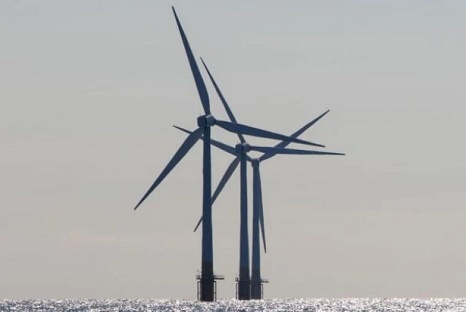
Offshore wind projects may be cancelled in NJ, according to report
Already facing a series of lawsuits and opposition from state and local officials, Danish wind power developer Orsted is reporting huge financial losses. Those losses, company officials warned, could reach $2.3 billion in the U.S and may force the cancellation of projects of the New Jersey coast. In a conference call with investors, Orsted CEO Mads Nipper told them, “If the walk-away scenario is the economical, rational decision for us, then this remains a real scenario for us.” Orsted is considering “walking away” from or cancelling projects in New Jersey, New York, Rhode Island, Connecticut and Maryland. >>click to read<< 08:48
Ørsted shares fall 25% after it reveals troubles in US business
 Shares in the world’s largest offshore wind company tumbled by nearly a quarter on Wednesday, after it said it may have to write down the value of its US portfolio by nearly £2bn. Ørsted said it had been hit by a flurry of setbacks in its American business, triggering a rapid sell-off in its shares, listed in Copenhagen. In their haste to dump the stock, investors had cut the notional value of the business by nearly £7bn by the time the market closed on Wednesday. It pointed to significant problems in the supply chain that are likely to affect Ocean Wind 1, Sunrise Wind, and Revolution Wind, planned windfarms off the eastern seaboard of the US. >>click to read<< 13:32
Shares in the world’s largest offshore wind company tumbled by nearly a quarter on Wednesday, after it said it may have to write down the value of its US portfolio by nearly £2bn. Ørsted said it had been hit by a flurry of setbacks in its American business, triggering a rapid sell-off in its shares, listed in Copenhagen. In their haste to dump the stock, investors had cut the notional value of the business by nearly £7bn by the time the market closed on Wednesday. It pointed to significant problems in the supply chain that are likely to affect Ocean Wind 1, Sunrise Wind, and Revolution Wind, planned windfarms off the eastern seaboard of the US. >>click to read<< 13:32
South Australia rejects proposed Southern Ocean offshore wind energy zone over lobster industry concern
 One state is bucking a push for more wind farms in Australia due to fears the gigantic renewable energy generators could damage vulnerable ocean wildlife and put hundreds of fishermen out of work. South Australia has officially notified the federal government it does not support a proposed Southern Ocean offshore wind farm zone stretching from Warrnambool in Victoria to Port MacDonnell in the state’s southeast Limestone Coast region. Primary Industries Minister Clare Scriven said the construction of massive turbines could damage the state’s $187.5m rock lobster industry, which generates more than 1000 full time jobs in the area. >>click to read<< 11:17
One state is bucking a push for more wind farms in Australia due to fears the gigantic renewable energy generators could damage vulnerable ocean wildlife and put hundreds of fishermen out of work. South Australia has officially notified the federal government it does not support a proposed Southern Ocean offshore wind farm zone stretching from Warrnambool in Victoria to Port MacDonnell in the state’s southeast Limestone Coast region. Primary Industries Minister Clare Scriven said the construction of massive turbines could damage the state’s $187.5m rock lobster industry, which generates more than 1000 full time jobs in the area. >>click to read<< 11:17

Experts fear American fishing industry, boating at risk as Biden prioritizes climate, green energy
The Biden administration has prioritized green energy at the expense of endangered whales and the U.S. fishing industry with regulation that limits both commercial fishing and recreational boating, according to experts. As they are imposing more regulations, they are also promoting offshore wind, which is actually harming commercial and recreational boating and potentially killing whales, Brady and Lapp said. “They positioned us as being these evildoers and now, 20 years later, whales are dropping dead like pigeons in Manhattan,” Brady said. “Here commercial fishermen and coastal communities are at the front line of fighting to protect the ocean itself, and we have crickets from virtually every NGO.” Video, >>click to read<< 09:09
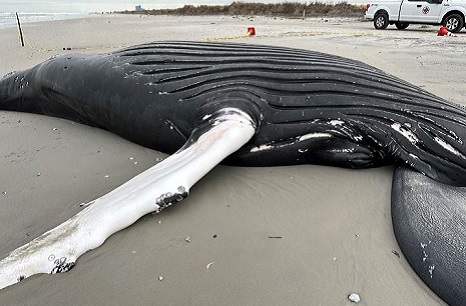
Green Groups Turn a Blind Eye to Mysterious Increase in Whale Deaths
Several environmentalist groups campaign against offshore oil and gas projects because of their ecological impacts, but those same groups appear to apply less scrutiny to the potential impacts of offshore wind developments. The Sierra Club, the League of Conservation Voters (LCV) and Greenpeace have all advocated for East Coast offshore wind projects amid the increase in whale deaths after slamming offshore oil and gas projects for their environmental impacts. The National Oceanic and Atmospheric Administration (NOAA) has declared “unusual mortality events” for humpback and North Atlantic right whales since 2016 and 2017, respectively, a timeline which generally coincides with the start of offshore wind development off of the East Coast in 2016, according to NOAA’s website. >>click to read<< 12:09

‘They’re not listening’: Fishermen, tribes voice concerns on two Oregon coast sites eyed for offshore wind farms
Last week, the Federal Bureau of Ocean Energy Management (BOEM) announced two draft Wind Energy Areas off the southern Oregon coast. One of them is offshore of Brookings, near the California border, the other off the coast of Coos Bay. The areas also represent prime fishing grounds and important cultural areas to local Indigenous tribes. Heather Mann, executive director of the Newport-based Midwater Trawlers Cooperative, said it feels like a lot of stakeholders’ concerns are being left unheard. “They’re not listening to coastal communities. They’re not listening to the fishing industry. They’re not listening to congressional representatives,” said Mann, whose organization represents 32 vessels that fish in the area. “Fishermen are not just concerned about being displaced from fishing grounds, though that is a critical piece. ” Video, >click to read< 11:35
A reporter went on the Jones Act Enforcer vessel monitoring Vineyard Wind. What she saw.
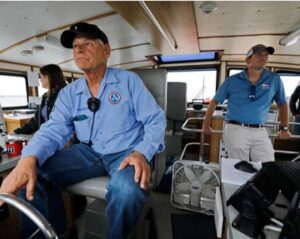 Aaron Smith, president and CEO of the Offshore Marine Service Association, was our host on this trip. It’s his intent on behalf of the association to be on the lookout for ships in violation of the Jones Act and taking jobs away from American workers. The ship is named after the Jones Act, a section of federal law that regulates maritime commerce in the United States by requiring that goods shipped between U.S. points be transported on ships that are built, owned and operated by United States citizens or permanent residents. Captain Rick Spaid and his crew sped through the water at about 17 knots give or take when he was able and brought us within about 0.5 nautical miles of the ships we saw. Photos, >click to read< 09:46
Aaron Smith, president and CEO of the Offshore Marine Service Association, was our host on this trip. It’s his intent on behalf of the association to be on the lookout for ships in violation of the Jones Act and taking jobs away from American workers. The ship is named after the Jones Act, a section of federal law that regulates maritime commerce in the United States by requiring that goods shipped between U.S. points be transported on ships that are built, owned and operated by United States citizens or permanent residents. Captain Rick Spaid and his crew sped through the water at about 17 knots give or take when he was able and brought us within about 0.5 nautical miles of the ships we saw. Photos, >click to read< 09:46
Senator Vin Gopal Says Whale Deaths are a Right Wing Conspiracy Theory
 New Jersey Democrat Senator Vin Gopal, a key ally in New Jersey Governor Phil Murphy’s mission to build wind turbines from Cape May to Sandy Hook said conspiracy theorists are linking a massive increase in whale deaths to offshore wind energy. When asked during a news 12 interview, Gopal, who is also very active politically in Ocean County too, rejected the idea that sonar mapping could be linked to a massive kill-off of whales and dolphins at the Jersey Shore in 2023. When asked if the offshore sonar mapping is responsible for the die off, Gopal was firm. “No, it is not,” he said. Residents criticized Gopal’s conspiracy theory assertion. Video, >click to read< 07:40
New Jersey Democrat Senator Vin Gopal, a key ally in New Jersey Governor Phil Murphy’s mission to build wind turbines from Cape May to Sandy Hook said conspiracy theorists are linking a massive increase in whale deaths to offshore wind energy. When asked during a news 12 interview, Gopal, who is also very active politically in Ocean County too, rejected the idea that sonar mapping could be linked to a massive kill-off of whales and dolphins at the Jersey Shore in 2023. When asked if the offshore sonar mapping is responsible for the die off, Gopal was firm. “No, it is not,” he said. Residents criticized Gopal’s conspiracy theory assertion. Video, >click to read< 07:40
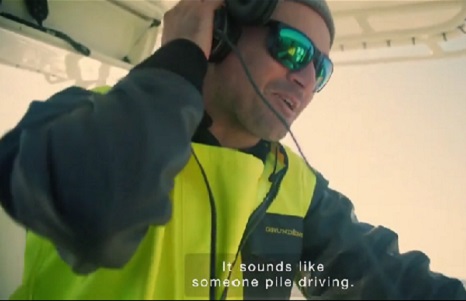
New documentary ‘proves’ building offshore wind farms does kills whales
The increase in whale, dolphin, and other cetacean deaths off the East Coast of the United States since 2016 is not due to the construction of large industrial wind turbines, U.S. government officials say. Their scientists have done the research, they say, to prove that whatever is killing the whales is completely unrelated to the wind industry. But now, a new documentary, “Thrown to the Wind,” by director and producer Jonah Markowitz, which I executive produced, proves that the US government officials have been lying. The film documents surprisingly loud, high-decibel sonar emitted by wind industry vessels when measured with state-of-the-art hydrophones. Video, >click to read<
Limestone Coast community fears it has a lot to lose if offshore wind zone goes ahead in Southern Ocean
 Australia’s Southern Ocean has some of the best wind resources in the world and is set to play a prominent part in the nation’s energy future. But in a small town on South Australia’s Limestone Coast, opposition to the development of offshore wind farms is fierce. Chris Carrison is an abalone diver and chair of Southern Coast Ocean Care, a group of Port Macdonnell residents against offshore wind. “Particularly from the cray fishermen and the future of their industry, but just the general public that they’re going to look out of their front yard and see a wind tower in the future.” Mr Carrison said locals were concerned the development could have a devastating effect on the local lobster fishing industry and the environment. >click to read< 08:02
Australia’s Southern Ocean has some of the best wind resources in the world and is set to play a prominent part in the nation’s energy future. But in a small town on South Australia’s Limestone Coast, opposition to the development of offshore wind farms is fierce. Chris Carrison is an abalone diver and chair of Southern Coast Ocean Care, a group of Port Macdonnell residents against offshore wind. “Particularly from the cray fishermen and the future of their industry, but just the general public that they’re going to look out of their front yard and see a wind tower in the future.” Mr Carrison said locals were concerned the development could have a devastating effect on the local lobster fishing industry and the environment. >click to read< 08:02
Save LBI lays out evidence for cause of whale deaths
 On August 4th, 2023, Save Long Beach Island (LBI) filed a lawsuit seeking to enjoin the ongoing offshore wind energy vessel surveys using high intensity noise equipment until a thorough investigation could be done and new protocols developed for estimating noise impacts from wind energy development activities. On August 14th Save LBI responded to defendant and defendant-intervenor motions, laying out in detail the evidence linking the vessel surveys to the recent whale deaths. Evidence of Causation of Whale Deaths by Vessel Surveys -The federal defendant concludes that the vessel surveys are not the cause of the recent whale and dolphin deaths, and that there is no evidence linking the two. In fact, there is ample evidence leading to a conclusion that the surveys were and are the only plausible cause, as summarized below: >click to read< 12:30
On August 4th, 2023, Save Long Beach Island (LBI) filed a lawsuit seeking to enjoin the ongoing offshore wind energy vessel surveys using high intensity noise equipment until a thorough investigation could be done and new protocols developed for estimating noise impacts from wind energy development activities. On August 14th Save LBI responded to defendant and defendant-intervenor motions, laying out in detail the evidence linking the vessel surveys to the recent whale deaths. Evidence of Causation of Whale Deaths by Vessel Surveys -The federal defendant concludes that the vessel surveys are not the cause of the recent whale and dolphin deaths, and that there is no evidence linking the two. In fact, there is ample evidence leading to a conclusion that the surveys were and are the only plausible cause, as summarized below: >click to read< 12:30
Opinion: Offshore wind, marine-life deaths by Carol Frazier
 Do you remember the line from “The Wizard of Oz” when Dorothy and her companions are on their way to Oz and are afraid of being attacked? The line was “Lions and tigers and bears – oh my! Lions and tigers and bears – oh my!” Well, I have revised that to “Murphy and Carney and Moore – oh my!” referring to the three Democrat governors of New Jersey, Delaware and Maryland who are absolutely determined to go full steam ahead on offshore wind, no matter what evidence of harm to wildlife and commercial fishing and the economy is presented. I read Doug Miller’s letter to the editor of Aug. 11 with interest, also. Regarding Mr. Miller’s statement that concern about whale deaths is nonsense, I beg to differ. >click to read< 08:54
Do you remember the line from “The Wizard of Oz” when Dorothy and her companions are on their way to Oz and are afraid of being attacked? The line was “Lions and tigers and bears – oh my! Lions and tigers and bears – oh my!” Well, I have revised that to “Murphy and Carney and Moore – oh my!” referring to the three Democrat governors of New Jersey, Delaware and Maryland who are absolutely determined to go full steam ahead on offshore wind, no matter what evidence of harm to wildlife and commercial fishing and the economy is presented. I read Doug Miller’s letter to the editor of Aug. 11 with interest, also. Regarding Mr. Miller’s statement that concern about whale deaths is nonsense, I beg to differ. >click to read< 08:54
Hundreds Protest New Jersey’s Offshore Wind Farms
 Concerns over the increase in whale and dolphin deaths along the Jersey Shore have ignited protests against Governor Phil Murphy’s support for offshore wind energy. On Tuesday, hundreds of protesters converged in Atlantic City to voice their concerns, backed by a theory linking these deaths to offshore sonar testing. The Jersey Shore has witnessed an unprecedented spike in marine mammal deaths in the past year alone. Activists from the ‘Save Right Whales Coalition’ and other environmental groups are attributing this alarming trend to sonar mapping activities that precede the construction of offshore wind turbines. However, Governor Murphy argues that the rise in marine fatalities is consistent with a long-term trend observed across the East Coast and not exclusively linked to the offshore wind projects in New Jersey. >click to read< 10:32
Concerns over the increase in whale and dolphin deaths along the Jersey Shore have ignited protests against Governor Phil Murphy’s support for offshore wind energy. On Tuesday, hundreds of protesters converged in Atlantic City to voice their concerns, backed by a theory linking these deaths to offshore sonar testing. The Jersey Shore has witnessed an unprecedented spike in marine mammal deaths in the past year alone. Activists from the ‘Save Right Whales Coalition’ and other environmental groups are attributing this alarming trend to sonar mapping activities that precede the construction of offshore wind turbines. However, Governor Murphy argues that the rise in marine fatalities is consistent with a long-term trend observed across the East Coast and not exclusively linked to the offshore wind projects in New Jersey. >click to read< 10:32

The NSW commercial fishing industry condemns offshore wind farm proposal for the Hunter and Illawarra regions
Tricia Beatty, Chief Executive Officer of the Professional Fishermen’s Association of NSW said today, “The proposal being considered by the Federal Government is ludicrous and will have a devastating impact on endangered, protected species as well as devastating our commercial fishing families and seafood consumers of New South Wales.” “The studies done to date demonstrates enough evidence that listed threatened species and ecological communities, as well as listed migratory species (protected under international agreements) will be impacted by the proposed wind farms. There is also some opinion amongst the scientific community that there is a link between both the increased mortality rate of whales alongside the expansion of offshore wind infrastructure on the busy coastal cities of New York and New Jersey, although this is still being studied. The areas proposed for the offshore windfarms is in the migratory path of important species such as southern right whales (one of the most endanger large whale species in the world) and humpback whales”, said Ms Beatty. >click to read< 08:40

Feds ask for public comment on two Oregon Coast sites slated for floating offshore wind farms
Two sites off the southern Oregon coast could soon be home to the state’s first floating offshore wind farms. But first, the federal Bureau of Ocean Energy Management will meet with residents and stakeholders in coastal towns, some of whom are concerned about impact to the fishing industry and marine ecosystems. Officials from the ocean energy bureau announced Tuesday that they had identified two ideal “wind energy areas” near Coos Bay and Brookings. The two areas are 20 or more miles from land, collectively encompass about 344 square miles of ocean and could host enough floating wind turbines to generate 2.6 gigawatts of electricity, enough to power about 195,000 homes. >click to read< 10:29
CT innovator IDs illegal trawlers with AI and ears in the ocean
 With millions of dollars from venture capital investors, a Connecticut startup that emerged from the submarine industry is using artificial intelligence to pioneer new underwater technology, from tracking illegal fishing to protecting whales during construction of offshore wind farms. Miles off the U.S. coast, Groton-based ThayerMahan is readying a nautical network of buoys and roaming sea drones to ID commercial fishing trawlers that may be operating illegally, whether in U.S. territorial waters or those of other nations where catch limits are abused routinely to put pressure on fish stocks. Closer to home in partnership with Hydrotechnik-Luebeck based in Germany, ThayerMahan is assisting offshore wind developers with a system to “bubble wrap” wind turbine monopiles with curtains of sound-absorbing bubbles,,, Photos, >click to read< 16:50
With millions of dollars from venture capital investors, a Connecticut startup that emerged from the submarine industry is using artificial intelligence to pioneer new underwater technology, from tracking illegal fishing to protecting whales during construction of offshore wind farms. Miles off the U.S. coast, Groton-based ThayerMahan is readying a nautical network of buoys and roaming sea drones to ID commercial fishing trawlers that may be operating illegally, whether in U.S. territorial waters or those of other nations where catch limits are abused routinely to put pressure on fish stocks. Closer to home in partnership with Hydrotechnik-Luebeck based in Germany, ThayerMahan is assisting offshore wind developers with a system to “bubble wrap” wind turbine monopiles with curtains of sound-absorbing bubbles,,, Photos, >click to read< 16:50
Offshore wind farms pose wildlife threat
 What with all the hype and grand economic plans for wind farming off Maryland’s coast, not one word from the project-movers on consequent harm to the sea’s wildlife, most notably the whales and fish. We are with Ocean City’s mayor and city council in linking the dead whales washed up on the coast with offshore wind harvesting. OC also doesn’t like the prospects for the “viewshed” — turbines visible in the distance. And has anyone considered the possible shift in the path of sharks? Do Maryland vacationers really want the ocean along our shores featuring lots of shark fins? Listen to the audio, or >click to read< By Bruce and Leslea Knauff 15:48
What with all the hype and grand economic plans for wind farming off Maryland’s coast, not one word from the project-movers on consequent harm to the sea’s wildlife, most notably the whales and fish. We are with Ocean City’s mayor and city council in linking the dead whales washed up on the coast with offshore wind harvesting. OC also doesn’t like the prospects for the “viewshed” — turbines visible in the distance. And has anyone considered the possible shift in the path of sharks? Do Maryland vacationers really want the ocean along our shores featuring lots of shark fins? Listen to the audio, or >click to read< By Bruce and Leslea Knauff 15:48
The Financial Viability of New Jersey’s Offshore Wind Farms Possibly in Jeopardy
 The final nail in the coffin for offshore wind energy projects on the East Coast might be in danger by the policies of the very same people touting clean energy. Politicians like New Jersey Governor Phil Murphy and President Joe Biden, more specifically, their economic policies on energy, inflation, labor and equity could be the foundation for the failure of the very programs they are trying to enable. Inflation, supply chain issues, and the increase in goods and services due to raw materials and crude oil prices could eventually sink their plans for massive offshore wind energy farms. New Jersey is not alone in facing challenges with offshore wind energy. Connecticut’s Park City Wind, an 800-megawatt project, also finds itself in danger. >click to read< 11:37
The final nail in the coffin for offshore wind energy projects on the East Coast might be in danger by the policies of the very same people touting clean energy. Politicians like New Jersey Governor Phil Murphy and President Joe Biden, more specifically, their economic policies on energy, inflation, labor and equity could be the foundation for the failure of the very programs they are trying to enable. Inflation, supply chain issues, and the increase in goods and services due to raw materials and crude oil prices could eventually sink their plans for massive offshore wind energy farms. New Jersey is not alone in facing challenges with offshore wind energy. Connecticut’s Park City Wind, an 800-megawatt project, also finds itself in danger. >click to read< 11:37
Murphy’s wind turbine project could be stopped by little ole Ocean City, N.J.
 Whether you’re a Democrat, Republican or independent, you have to know Phil Murphy is as slick and slippery as they come. Rather than go through the Legislature for approval of his climate cult schemes, he does it through the regulatory process. This way you have no say in the matter. It just gets rammed through by way of the BPU or the DEP. They’re made up of unelected bureaucrats appointed by the governor. Back in March Murphy chose not to reappoint two people that might offer resistance to any of his climate cult nonsense, like getting rid of gas stoves, gasoline-powered cars or giant wind turbines off the Jersey Shore. >click to read< 14:53
Whether you’re a Democrat, Republican or independent, you have to know Phil Murphy is as slick and slippery as they come. Rather than go through the Legislature for approval of his climate cult schemes, he does it through the regulatory process. This way you have no say in the matter. It just gets rammed through by way of the BPU or the DEP. They’re made up of unelected bureaucrats appointed by the governor. Back in March Murphy chose not to reappoint two people that might offer resistance to any of his climate cult nonsense, like getting rid of gas stoves, gasoline-powered cars or giant wind turbines off the Jersey Shore. >click to read< 14:53
New Bedford said to be best place for National Oceanic and Atmospheric Administration
 Is there a better place to site the National Oceanic and Atmospheric Administration’s Northeast operations than New Bedford? Mayor Jon Mitchell doesn’t think so. And he’s joined in that opinion by a “very broad coalition of business and civic leadership. “Mitchell sent a letter co-signed by more than 50 business and civic leaders to NOAA Administrator Richard Spinrad this month making a pitch to consolidate its Northeast facilities in New Bedford. A similar letter was sent to NOAA in 2016, but recent developments warranted another entreaty. New Bedford’s port accounts for about 70% of the state’s commercial fish landings, according to the letter. While Gloucester hosts most of the NOAA’s facilities regionally, its landings are about one-seventh the size of New Bedford’s. >click to read< 09:54
Is there a better place to site the National Oceanic and Atmospheric Administration’s Northeast operations than New Bedford? Mayor Jon Mitchell doesn’t think so. And he’s joined in that opinion by a “very broad coalition of business and civic leadership. “Mitchell sent a letter co-signed by more than 50 business and civic leaders to NOAA Administrator Richard Spinrad this month making a pitch to consolidate its Northeast facilities in New Bedford. A similar letter was sent to NOAA in 2016, but recent developments warranted another entreaty. New Bedford’s port accounts for about 70% of the state’s commercial fish landings, according to the letter. While Gloucester hosts most of the NOAA’s facilities regionally, its landings are about one-seventh the size of New Bedford’s. >click to read< 09:54
Fishermen slam Biden admin’s offshore wind push as threat to jobs, sea life
 The New England Fishermen’s Stewardship Association (NEFSA) on Monday released an Offshore Wind Research Summary, a compilation of scholarly articles that identify dangers offshore wind farms pose to ocean ecosystems. “We cannot industrialize the Gulf of Maine until we understand how the wind industry interacts with the fisheries that wild harvesters have stewarded responsibly for decades,” said Jerry Leeman, NEFSA CEO and a longtime commercial fishing captain. Leeman says that the government’s attempt to justify wind farms leans on “voodoo science” because the proper methods and sufficient amount of time have not been applied. “The problem is the science that wraps around the science, the whole purpose for it is misinterpreted to the public through the fact that they think they’re getting real, accurate science,” Leeman said. >click to read<
The New England Fishermen’s Stewardship Association (NEFSA) on Monday released an Offshore Wind Research Summary, a compilation of scholarly articles that identify dangers offshore wind farms pose to ocean ecosystems. “We cannot industrialize the Gulf of Maine until we understand how the wind industry interacts with the fisheries that wild harvesters have stewarded responsibly for decades,” said Jerry Leeman, NEFSA CEO and a longtime commercial fishing captain. Leeman says that the government’s attempt to justify wind farms leans on “voodoo science” because the proper methods and sufficient amount of time have not been applied. “The problem is the science that wraps around the science, the whole purpose for it is misinterpreted to the public through the fact that they think they’re getting real, accurate science,” Leeman said. >click to read<

OFFSHORE WIND OPPONENTS NEED A MASS PROTEST IN WASHINGTON DC – BY JIM LOVGREN
In 2010 and 2012 fishermen held two different successful protests in Washington DC with thousands of fishermen travelling from around the country to attend. Both commercial and recreational fishermen voiced their concerns regarding catch shares and Magnuson Act reauthorization, among the multitude of issues that threatened their livelihoods. Today, the fishing industry is facing a far worse enemy then fishery management, as thousands of square miles of their historic fishing grounds have been auctioned off to the highest bidder in order to make way for the wildlife killing machines called wind turbines. These auctions have been held by BOEM, the Bureau of Ocean Energy Management, a part of the Department of the Interior. They are charged with the selling or leasing of US natural resources in our offshore waters, and apparently, they have absolutely no regard for any wildlife that may exist within them, or any people who might derive a living from catching said wildlife. >click to read< 11:50
Why offshore wind jobs may just be a lot of hot air
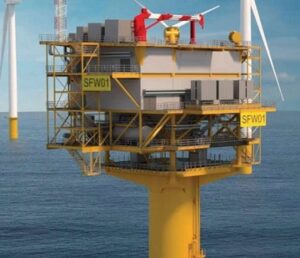 Offshore wind developers in the U.S. have promised to create thousands of “million-dollar” jobs. But those dollars won’t flow into New York workers’ paychecks. Rather, they’re just the sum total of the subsidies local taxpayers and utility ratepayers will expend to keep offshore wind afloat, as if New Yorkers’ electric bills aren’t high enough. Consider Ørsted, the Danish government-owned company that is developing the 12-turbine, 132-megawatt Southfork Wind and the 84-turbine, 924-megawatt Sunrise Wind projects, which will be built 30 miles east of Montauk Point, Long Island. Ørsted is also behind the 98-turbine, 1,100 megawatt Ocean Wind project along the southern New Jersey shore, which just rewarded it with several billion dollars in tax credits that were supposed to have been returned to New Jersey ratepayers According to Ørsted’s Southfork Construction and Operations Plan (COP), Southfork will require 166 construction workers each year during the two-year construction period and another 10 jobs each year for operation and maintenance over the project’s 25-year expected lifespan. >click to read< 09:35
Offshore wind developers in the U.S. have promised to create thousands of “million-dollar” jobs. But those dollars won’t flow into New York workers’ paychecks. Rather, they’re just the sum total of the subsidies local taxpayers and utility ratepayers will expend to keep offshore wind afloat, as if New Yorkers’ electric bills aren’t high enough. Consider Ørsted, the Danish government-owned company that is developing the 12-turbine, 132-megawatt Southfork Wind and the 84-turbine, 924-megawatt Sunrise Wind projects, which will be built 30 miles east of Montauk Point, Long Island. Ørsted is also behind the 98-turbine, 1,100 megawatt Ocean Wind project along the southern New Jersey shore, which just rewarded it with several billion dollars in tax credits that were supposed to have been returned to New Jersey ratepayers According to Ørsted’s Southfork Construction and Operations Plan (COP), Southfork will require 166 construction workers each year during the two-year construction period and another 10 jobs each year for operation and maintenance over the project’s 25-year expected lifespan. >click to read< 09:35
Fishermen, activists protesting offshore wind projects on the East Coast
 Critics are sounding the alarm on the ecological consequences of the Biden administration’s green energy agenda, specifically the increase marine wildlife deaths in conjunction with offshore wind farms. Activists along with local fishermen are particularly concerned about the rise in whale and dolphin beaching. “What we’re seeing is a failure to properly manage the situation,” Rhode Island fisherman Chris Brown said. “The whales have been migrating from their southern stations during the spring up through the mid-Atlantic region, and they didn’t even slow down the acoustic carpet bombing. And as a result, the Atlantic was littered with the dead whales and dolphins and sharks. There doesn’t seem to be any environmental concern. This is a manmade environmental disaster that’s unfolding. I expect that it will half a whale population in 10 years and probably the same for our fish.”Video, photos, >click to read< 19:17
Critics are sounding the alarm on the ecological consequences of the Biden administration’s green energy agenda, specifically the increase marine wildlife deaths in conjunction with offshore wind farms. Activists along with local fishermen are particularly concerned about the rise in whale and dolphin beaching. “What we’re seeing is a failure to properly manage the situation,” Rhode Island fisherman Chris Brown said. “The whales have been migrating from their southern stations during the spring up through the mid-Atlantic region, and they didn’t even slow down the acoustic carpet bombing. And as a result, the Atlantic was littered with the dead whales and dolphins and sharks. There doesn’t seem to be any environmental concern. This is a manmade environmental disaster that’s unfolding. I expect that it will half a whale population in 10 years and probably the same for our fish.”Video, photos, >click to read< 19:17


















































Perplexing Comments by Coughlin, Scutari on offshore wind surprise many involved in industry
Share this post